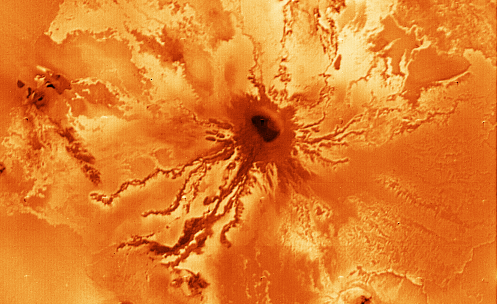It’s time for another Where In The Universe Challenge! This WITU was submitted by UT reader David Schumaker. Name where in the Universe this image was taken and give yourself extra points if you can name the telescope or spacecraft responsible for the image. Post your guesses in the comments section, and check back on later at this same post to find the answer. To make this challenge fun for everyone, please don’t include links or extensive explanations with your answer. Good luck!
UPDATE: The answer has now been posted below.
This is a closeup of a volcano named Ra Patera on Jupiter’s moon Io, taken by one of the Voyager spacecraft in 1979. Voyager 1 made a spectacular and unexpected discovery that Io, the innermost Galilean moon of Jupiter, was covered with volcanoes and some of them were erupting! Voyager 1 observed nine volcanic eruptions during its encounter with the moon, and four months later, when Voyager 2 flew past, it was able to confirm that at least six of them were still erupting.
See more about this image on APOD. Many thanks to David Schumaker for suggesting this image for WITU! Submit any ideas you have for future WITUs to Nancy.


Looks like Io, picture taken maybe by Galileo spacecraft not the man.
Obviously Io.
Io, image taken by Voyager (not Galileo).
“Ra Patera” Volcano from IO. taken from Voyager 1.
This is Ra Patera, a volcano of Io one of Jupiter’s moon. It was taken by Voyager..
It’s the Ra Petara shield volcano on Io, and the image was taken by Voyager 1 in 1979.
Yes, it is the Ra Patera volcano in Io, the innermost moon of Jupiter. This picture was taken by Voyage 1 in March 1979
Dude, can’t you read? – “please don’t include links or extensive explanations with your answer”!
Oh, sorry.
As others have already noted, it’s the volcano Ra on Io. (Patera is just Latin for saucer, and it’s a class of low volcanoes found on many solar system bodies.) Image taken by the
Galileo spacecraft in 2001, OK, Voyager 1 in 1979.Darnit! Rwinrich beat me to it. I think it’s Io as well. It has the typical coloration, and Io has no shortage of volcanic activity either. This would, as agreed, be taken from the Galileo spacecraft, no telescope.
Alejandro is correct!